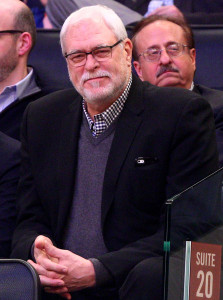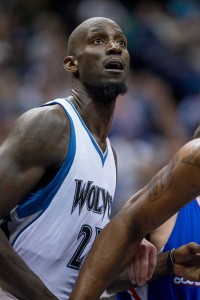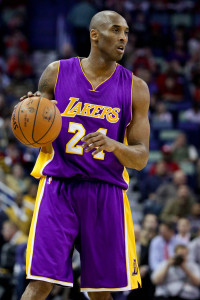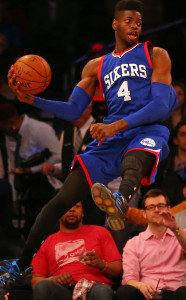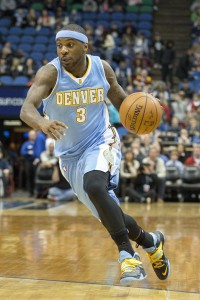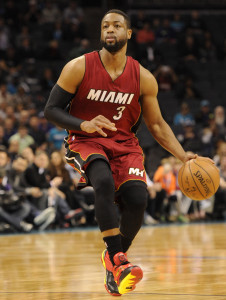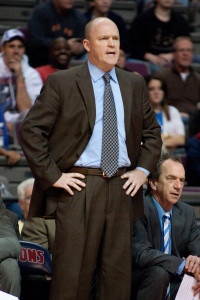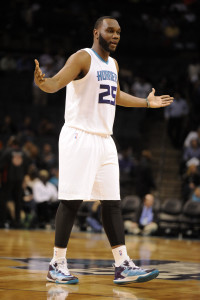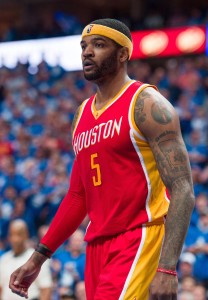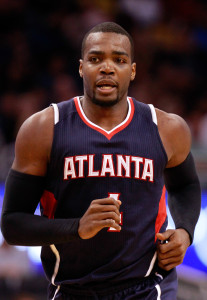Guaranteed Contracts
- Carmelo Anthony ($22,875,000)
- Jose Calderon ($7,402,812)
- Tim Hardaway Jr. ($1,304,520)
- Cleanthony Early ($845,059)
Non-Guaranteed Contracts
- Ricky Ledo ($947,276)1
- Langston Galloway ($845,059)2
Options
- None
Restricted Free Agents/Cap Holds
- Alexey Shved ($6,235,908) — $4,102,571 qualifying offer
- Quincy Acy ($1,181,348) — $1,181,348 qualifying offer3
- Travis Wear ($1,045,059) — $1,045,059 qualifying offer4
Unrestricted Free Agents/Cap Holds
- Andrea Bargnani ($17,250,000)
- Jason Smith ($3,933,600)
- No. 4 pick ($3,443,100)
- Shane Larkin ($1,675,320)
- Cole Aldrich ($947,276)
- Lou Amundson ($947,276)
- Lance Thomas ($947,276)
- (Baron Davis $947,276)5
- (Mike Bibby $947,276)5
Draft Picks
- 1st Round (4th overall)
Cap Outlook
- Guaranteed Salary: $32,427,391
- Non-Guaranteed Salary: $1,792,335
- Options: $0
- Cap Holds: $39,500,715
- Total: $73,720,441
The Knicks stumbled to a 17-65 record this season, but their most damaging loss may have come at the draft lottery. New York was the only team to drop when the ping pong balls were drawn May 19th, sliding from second to fourth and lessening the potential reward for a miserable season. The Knicks hurt their own cause with three April wins that allowed Minnesota to finish with the league’s worst record. With the best odds to win the lottery, the Timberwolves came away with the top pick.
Knicks fans were expecting something closer to 65 wins after Phil Jackson reached an agreement to become team president in March of 2014. But the season soured quickly for Jackson and rookie coach Derek Fisher. The first self-inflicted wound was a trade that sent Tyson Chandler and Raymond Felton to Dallas in exchange for Samuel Dalembert, Jose Calderon, Shane Larkin, Wayne Ellington and two draft picks that became Cleanthony Early and Thanasis Antetokounmpo. While Chandler gave the Mavericks the rim protector they needed and helped Dallas reach the playoffs, the deal worked out much worse for New York. Dalembert appeared in just 32 games before being waived January 5th. Calderon battled injuries throughout the season and is on the books for two more years at more than $15MM. Larkin started 22 games, but shot just 30% from three-point range and is an unrestricted free agent. Ellington was traded to the Kings before the season started and ended the year with the Lakers. Early saw limited playing time in 39 games, and Antetokounmpo spent the year in the D-League.
Even worse was a knee injury to Carmelo Anthony in the first season of a five-year contract worth more than $124MM. When Anthony spurned several suitors last July to re-sign in New York, it was hailed as a sign of a turnaround. However, the balky knee limited the Knicks star to just 40 games in which he averaged 24.2 points and 6.6 rebounds. He was voted into a starting spot in the All-Star Game by the fans, but was shut down for the season shortly afterward to undergo surgery on a patellar tendon in his left knee.
Any Knicks optimism for 2015/16 centers around the return of a healthy Anthony, success in the draft and an estimated $27MM to spend on free agents. Anthony recently told Ian Begley of ESPN.com that his recovery is ahead of schedule and he is “doing very well.” The draft prospects appear murky as Kentucky center Karl-Anthony Towns seems headed to the Wolves with the first pick, and the Knicks’ wish that either Duke center Jahlil Okafor or Ohio State point guard D’Angelo Russell slides to No. 4 is not expected to come true. There has been speculation that New York may wind up dealing its pick if those three are off the board.
The Knicks are pinning most of their hopes on free agency, as Jackson explained in April and as Marc Berman of The New York Post relayed. “In the present day in the NBA, 19-, 20-year-olds, coming into the league, it’s really hard to project what that player will be like in his first contract situation,’’ Jackson said. “We know what the first-round pick will mean to us, but we also know we will build the team on free agents. We have 190 players or so who will be free agents. That’s where our priority stands.’’ The Pistons’ Greg Monroe has emerged as a prime target as New York hopes to add some much-needed size. However, some other marquee players may already be out of reach. The Blazers’ LaMarcus Aldridge isn’t expected to consider New York because of its status as a rebuilding team, according to Ric Bucher of Bleacher Report, and Grizzlies’ center Marc Gasol isn’t cut out for the New York lifestyle, at least according to teammate Beno Udrih. “They’re not going to get him,” Udrih said to Bleacher Report’s Jared Zwerling. “He’s a laid-back guy and doesn’t like drama.” In April, Berman speculated about other possible Knicks targets, mentioning Monroe, along with Paul Millsap, Rajon Rondo, Wesley Matthews, DeAndre Jordan, Robin Lopez, Tobias Harris, DeMarre Carroll, Khris Middleton, Danny Green and Patrick Beverley.
The Knicks also have several of their own free agents to address. Andrea Bargnani will be an unrestricted free agent after eating up $17.25MM in cap space last season. He would like to return to New York, but the Knicks are reportedly only interested at a minimum salary. In addition to Larkin, Jason Smith, Cole Aldrich, Louis Amundson and Lance Thomas will all become unrestricted free agents in July, and their prospects will be tied to what New York does in free agency. Alexey Shved, Quincy Acy and Travis Wear will be restricted free agents. All of the team’s incumbent free agents would like to come back, GM Steve Mills said recently, but whether the Knicks want much of the same cast from this year to return is another story.
After a disastrous season on nearly every front, the Knicks have a lot of work ahead to get back on the road to respectability. The key remains Jackson who, with 11 NBA championships as a head coach, was thought to be a major selling point in attracting stars to New York. However, the 17-65 debacle has taken away some of his allure. Warriors board member/consultant Jerry West, who had enormous success in the league both as a player and GM, recently took swipes at Jackson in a radio interview on SiriusXM Bleacher Report Radio’s “NBA Sunday Tip.” “It’s a completely different challenge for him,” West said of Jackson’s role in New York. “He’s had teams with enormous talent. He’s coached them brilliantly and won championships, but it’s a different challenge for him.’’ West said Jackson damaged his reputation not only with the Dallas trade, but also with a three-team deal in January that sent Iman Shumpert and J.R. Smith to the Eastern Conference champion Cavaliers, while bringing back Amundson, Alex Kirk, Lance Thomas and a 2019 second-round pick. “With Phil, it’s going to be interesting to see what happens back there,” West said. “They didn’t have the kind of year I’m sure they wanted to have. Everyone in the league feels like they made two trades that made helped Cleveland tremendously and one that helped Dallas.’’ If West’s assessment is shared throughout the league, top-tier free agents won’t be ready to take the Knicks seriously and the rebuilding process in New York could be much longer than anyone wants to admit.
Cap Footnotes
1 — Ledo’s salary becomes partially guaranteed for $100K if he remains under contract through August 1st, and it becomes partially guaranteed for $200K if he remains under contract through the date of his team’s first regular season game.
2 — Galloway’s salary becomes partially guaranteed for $220K if he remains under contract through July 1st, and it becomes partially guaranteed for $440K if he remains under contract through September 15th.
3 — The cap hold for Acy would be $947,276 if the Knicks elect not to tender a qualifying offer.
4 — The cap hold for Wear would be $845,059 if the Knicks elect not to tender a qualifying offer.
5 — See our glossary entry on cap holds for an explanation of why these players technically remain on the books.
The Basketball Insiders Salary Pages were used in the creation of this post.
